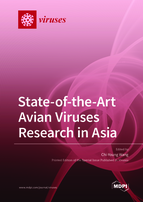State-of-the-Art Avian Viruses Research in Asia
A special issue of Viruses (ISSN 1999-4915). This special issue belongs to the section "Animal Viruses".
Deadline for manuscript submissions: closed (31 July 2022) | Viewed by 26719
Special Issue Editor
2. The iEGG and Animal Biotechnology Center, National Chung Hsing University, Taichung, Taiwan
Interests: avian virology; virus-like particles (VLPs); avian disease; cytokines
Special Issues, Collections and Topics in MDPI journals
Special Issue Information
Dear Colleagues,
To date, the rapid progression in avian virus research in Asia has resulted in an abundant achievement. This has mainly contributed to the development of some innovative techniques, advanced approaches, and the timely resolution of urgent issues. More and more new research topics focusing on emerging novel viruses have been found in various avian species. As the source of an important food supply, retaining the health of the birds remains the first priority for the poultry industry and research teams around Asia. Therefore, the accumulated knowledge about the fundamental biology, pathogenicity, epidemiology, antiviral strategies, vaccination schemes, and exceptional applications of avian viruses built up by those expertized research groups in Asia has accelerated the overall understanding of those key pathogens.
Thus, the presentation of research articles, short communications, and review papers on all research aspects of avian viruses from Asia is highly welcome in this Special Issue.
Prof. Dr. Chi-Young Wang
Guest Editor
Manuscript Submission Information
Manuscripts should be submitted online at www.mdpi.com by registering and logging in to this website. Once you are registered, click here to go to the submission form. Manuscripts can be submitted until the deadline. All submissions that pass pre-check are peer-reviewed. Accepted papers will be published continuously in the journal (as soon as accepted) and will be listed together on the special issue website. Research articles, review articles as well as short communications are invited. For planned papers, a title and short abstract (about 100 words) can be sent to the Editorial Office for announcement on this website.
Submitted manuscripts should not have been published previously, nor be under consideration for publication elsewhere (except conference proceedings papers). All manuscripts are thoroughly refereed through a single-blind peer-review process. A guide for authors and other relevant information for submission of manuscripts is available on the Instructions for Authors page. Viruses is an international peer-reviewed open access monthly journal published by MDPI.
Please visit the Instructions for Authors page before submitting a manuscript. The Article Processing Charge (APC) for publication in this open access journal is 2600 CHF (Swiss Francs). Submitted papers should be well formatted and use good English. Authors may use MDPI's English editing service prior to publication or during author revisions.
Keywords
- avian influenza virus
- infectious bronchitis virus
- infectious bursal disease virus
- infectious laryngotracheitis virus
- Marek's disease virus
- avian polyomavirus
- avian circovirus
- avian reovirus
- poultry diseases







